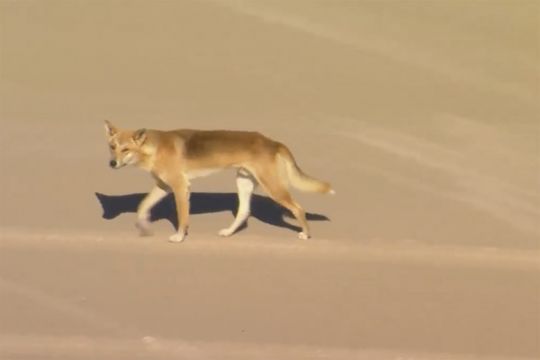A jogger has been attacked by a pack of dingoes while running on an Australian beach.
She was mauled in the latest clash between native dogs and humans on Queensland state’s K’gari – sparking fresh warnings to visitors.
The 24-year-old was attacked by three or four dingoes while running on Monday, officials said.
She was rescued by two passersby after being chased into the surf – with the canines using the same hunting technique they use for larger prey such as wallabies, wildlife ranger Linda Behrendorff said.
The World Heritage-listed national park K’gari, once known as Fraser Island, is the world’s largest sand island.
It is home to some of Australia’s purest dingoes, which are also known by their Indigenous name wongari, because domestic dogs have long been banned.
Tourists returned to the island after pandemic restrictions were lifted and have found the dingoes to be less wary of humans – raising the danger to both species, Ms Behrendorff said.
The woman was airlifted to Hervey Bay Hospital on the mainland in a stable condition suffering from multiple bite wounds to her limbs and body, the Queensland Ambulance Service said.
Park authorities are considering whether or not to destroy the dingo pack, which includes one that was collared due to previous “high risk behaviour” toward humans, Ms Behrendorff said.
A dingo last month became to the first to be destroyed on the island since 2019 after it attacked a seven-year-old boy and nipped a 42-year-old French tourist on the buttocks.
Dingoes are a protected species.
Visitors to the island are warned to beware of dingoes.
Tourists are advised not to run or jog outside fenced areas, to keep children within arm’s reach, to walk with a stick and to avoid providing dingoes with food.
Dingoes mostly approach humans for food.
The situation would be far safer without tourists’ need for selfies with wildlife to post on social media, Ms Behrendorff said.
“Those people are putting themselves at risk and they’re putting that animal at risk by calling them over to get a selfish shot in order to post that in a situation that makes themselves look like a big hero,” she told Australian Broadcasting Corp.
“They don’t understand the risks that they’ve put themselves and even that animal into.”
Ms Behrendorff cited a recent example of a man posting a photograph of him hand-feeding a dingo while a toddler was next to him.
“We spend most of our time trying to manage people. Dingoes will do what dingoes do. Dingoes are easy to work out,” Ms Behrendorff said.
Darren Blake, a member of the Butchulla Aboriginal Corp, which represents K’gari’s traditional owners, said visitors need to understand dingoes are far different from domestic dogs.
“My heart goes out to the young lady and hopefully this hits home for everybody else,” Mr Blake said, referring to the victim of Monday’s attack.
“They’re not puppy dogs. They’re wild, apex predators. Give them that respect,” he added.
George Seymour, mayor of the local Fraser Coast Regional Council, said there seems to have been more attacks on the island in the last two years than there were in the previous decade.
“Something different is happening over the past two years,” he said, referring to the frequency on dingo interactions with people.
The change was “very, very concerning because it’s extremely terrifying to be attacked by wildlife”, Mr Seymour added.







